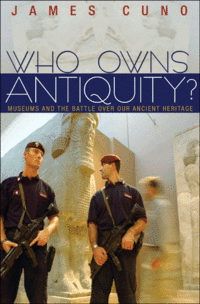Source of book image: http://press.princeton.edu/images/k8602.gif
(p. D1) In some cases, it makes aesthetic or archaeological sense to keep artifacts grouped together where they were found, but it can also be risky to leave everything in one place, particularly if the country is in turmoil or can’t afford to excavate or guard all its treasures. After the Metropolitan Museum was pressured to hand over a collection called the Lydian Hoard, one of the most valuable (p. D2) pieces was stolen several years ago from its new home in Turkey.
. . .
(p. D2) In his book “Who Owns Antiquity?”, James Cuno argues that scholars have betrayed their principles by acquiescing to politicians who have exploited antiquities to legitimize themselves and their governments. Saddam Hussein was the most blatant, turning Iraqi archeology museums into propaganda for himself as the modern Nebuchadnezzar, but other leaders have been just as cynical in using antiquities to bolster their claims of sovereignty.Dr. Cuno advocates the revival of partage, the traditional system in which archeologists digging in foreign countries would give some of their discoveries to the host country and take others home. That way both sides benefit, and both sides have incentives to recover antiquities before looters beat them to it. . . .
As the director of the Art Institute of Chicago, Dr. Cuno has his own obvious motives for acquiring foreign antiquities, and he makes no apology for wanting to display Middle Eastern statues to Midwesterners.
“It is in the nature of our species to connect and exchange,” Dr. Cuno writes. “And the result is a common culture in which we all have a stake. It is not, and can never be, the property of one modern nation or another.”
Some of the most culturally protectionist nations today, like Egypt, Italy and Turkey, are trying to hoard treasures that couldn’t have been created without the inspiration provided by imported works of art. (Imagine the Renaissance without the influence of “looted” Greek antiquities.) And the current political rulers of those countries often have little in common culturally with the creators of the artifacts they claim to own.
For the full commentary, see:
JOHN TIERNEY. “FINDINGS; A Case in Antiquities for ‘Finders Keepers’.” The New York Times (Tues., November 17, 2009): B6.
(Note: ellipses added.)
(Note: the online version of the commentary is dated November 16, 2009.)
The Cuno book discussed above, is:
Cuno, James. Who Owns Antiquity?: Museums and the Battle over Our Ancient Heritage. Princeton, NJ: Princeton University Press, 2008.

